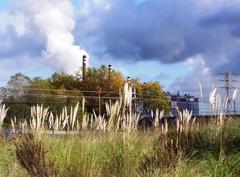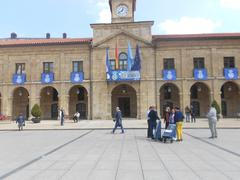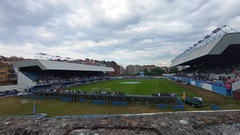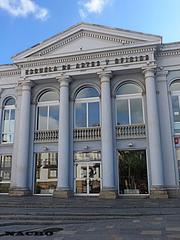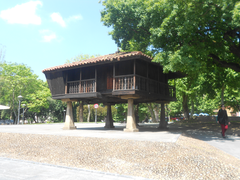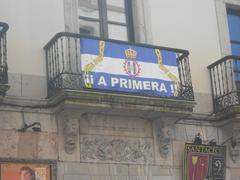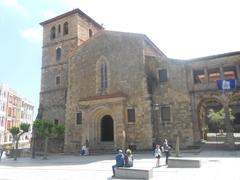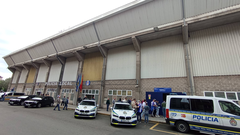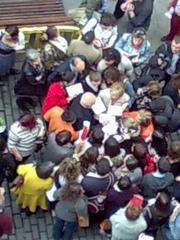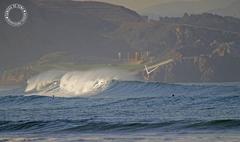
Comprehensive Guide to Visiting Avilés, Province of Asturias, Spain
Date: 14/08/2024
Captivating Introduction
Welcome to Avilés, a city where history and modernity dance seamlessly together, creating a mosaic of ancient tales and contemporary innovations. Imagine wandering through streets that whisper Roman secrets and medieval marvels while being greeted by the bold architecture of the Oscar Niemeyer International Cultural Centre. This city, once a prehistoric settlement, has evolved into a dynamic cultural hub, balancing its rich past with a vibrant present (Wikipedia). Picture yourself savoring a ‘bollu preñáu’—that delightful chorizo-stuffed bread—as you explore the ancient footprints left by Roman sandals on these very streets (Living Asturias). Whether you’re drawn to its Gothic churches, Baroque palaces, or modern architectural wonders, Avilés promises to captivate your senses and ignite your curiosity. So, lace up your walking shoes and get ready to uncover the myriad layers of this enchanting city.
Table of Contents
- Historical Background of Avilés
- Cultural and Architectural Highlights
- Visitor Tips for Avilés
- Call to Action
- References
Historical Background of Avilés
Earliest Footprints and Roman Whispers
The area around Avilés was settled during the Upper Paleolithic era. Fast forward, and you’ll find the Romans leaving their mark. The name ‘Avilés’ likely hails from a Roman landowner or a Romanized Germanic warrior named Abilius. Imagine Roman sandals clacking on these very streets, setting the stage for future greatness (Wikipedia).
Medieval Marvels: The Rise of Avilés
The first historical mention of Avilés came in 905 AD from King Alfonso III of Asturias. By the Middle Ages, Avilés was a prominent port on the Bay of Biscay. The town had two main districts: the fishermen’s Sabugo and the aristocratic La Villa, separated by a tiny water inlet. In 1085, King Alfonso VI of León granted Avilés city rights through the Charter of Avilés, boosting its economic and social status (Wikipedia). Alfonso VII of León ratified the Charter in the 12th century, leading to the construction of a city wall, remnants of which are still visible today (Living Asturias).
Renaissance and Early Modern Period: Markets and Mariners
By the 15th century, Avilés was flourishing. On January 15, 1479, the Catholic Monarchs granted the town the right to host a free market every Monday. The town’s shipbuilding prowess was notable, and local sailors even participated in the Castilian conquest of Seville, a feat proudly displayed on Avilés’s coat of arms (Wikipedia).
Industrial Revolution: The Steel Heartbeat
The 19th and 20th centuries ushered in an industrial boom for Avilés. The port became a trade hotspot with America and Cuba. In 1957, the metallurgical company Ensidesa (now Aceralia) established operations, transforming Avilés into an industrial powerhouse and attracting migrants from across Spain (Living Asturias).
Architectural Wonders: A Stroll Through Time
Avilés is an open-air museum where you can time-travel just by walking its streets. The historic center, dubbed ‘Villa del Adelantado’ in honor of Admiral Pedro Menéndez de Avilés, showcases buildings from different eras. Gothic churches like San Nicolás and San Francisco stand shoulder to shoulder with the palaces of Camposagrado and Ferrera. In 1955, the old district was declared a Historic-Artistic Site, preserving its Romanesque, Gothic, Baroque, and Art Nouveau styles (Where is Asturias).
A Modern Cultural Renaissance
In 2011, the Oscar Niemeyer International Cultural Centre opened its doors, ushering in a new cultural era for Avilés. Designed by the legendary Brazilian architect Oscar Niemeyer, this center is a beacon of modernity, hosting various events and exhibitions. Its sleek design contrasts beautifully with the medieval backdrop, symbolizing Avilés’s blend of the old and new (The Orange Backpack).
Key Historical Sites
- Church of San Nicolás de Bari: This Gothic gem is one of the oldest religious buildings in Avilés.
- Palacio de Valdecarzana: A medieval palace that exemplifies architectural grandeur.
- Palacio de Camposagrado: Reflecting the wealth and influence of Avilés’s noble families.
- Oscar Niemeyer International Cultural Centre: A modern cultural hub that has breathed new life into Avilés (Spain.info).
Festivals and Fun Times
Avilés is a party town with a calendar full of vibrant festivals. The Bollu Festival during Holy Week is over 120 years old and features parades, music, and traditional Asturian cuisine (Asturias Tourism).
Cultural and Architectural Highlights
Plaza de España: The Heartbeat of Avilés
Start your adventure at Plaza de España, affectionately known as El Parche. Picture a bustling square surrounded by opulent Baroque buildings like the Palacio Valdecarzana and Camposagrado Palace, each whispering tales of 17th-century nobility (Palacio Valdecarzana). Feeling peckish? Grab a seat at a nearby café and indulge in some people-watching – a local pastime!
Church of Saint Nicholas of Bari: A Gothic Masterpiece
Just a hop, skip, and a jump from Plaza de España lies the Church of Saint Nicholas of Bari. This 13th-century Gothic marvel will transport you back in time with its stunning stained-glass windows and majestic architecture.
Calle Galiana: A Stroll Through Time
Calle Galiana is a dreamy, pedestrian-only street lined with colorful houses featuring traditional Asturian balconies known as galerías. Take your time to explore the local boutiques and perhaps even stumble upon a hidden courtyard café.
El Adelantado de San Agustín: Saluting a Local Hero
Meet Pedro Menéndez de Avilés, the city’s proud son, immortalized in the statue of El Adelantado de San Agustín. Did you know he founded St. Augustine, Florida? Snap a selfie with the statue and explore the nearby Palacio Valdés Theatre, a cultural haven hosting a medley of events throughout the year.
Oscar Niemeyer International Cultural Center: A Modern Marvel
Ready for a splash of modernity? The Oscar Niemeyer International Cultural Center stands as a bold testament to contemporary design by the legendary Brazilian architect. This eye-catching structure houses a variety of exhibitions, merging the old and new in Avilés’ vibrant cultural tapestry.
Ferrera Park: Nature’s Embrace
Escape the urban bustle in Ferrera Park, an oasis of tranquility. Imagine the rustle of leaves and the gentle ripple of fishponds as you unwind on a bench. This lush retreat, often dubbed the city’s green lung, is perfect for a leisurely walk or a picturesque picnic.
Culinary Delights: A Feast for the Senses
No visit to Avilés is complete without sampling its culinary delights. From hearty fabada asturiana to the succulent cachopo, your taste buds are in for a treat. Pop by Tierra Astur cider house or San Francisco Walnut Tree for a mouthwatering experience.
Accommodation: Rest Your Head in Style
Whether you prefer boutique hotels or beachfront resorts, Avilés has something for everyone. Enjoy a cozy stay in a bed & breakfast or revel in the luxury of a design hotel.
Festivals and Cultural Events: Join the Celebration
Dive into Avilés’ vibrant festival scene, from the solemn Holy Week Processions to the lively Summer Carnival. Plaza de España comes alive with music, dance, and color, offering a feast for the senses.
Practical Tips: Navigate Like a Pro
Avilés is a walker’s paradise with most attractions within easy reach. The best time to visit is during the warm summer months (June to August) when the city’s charm is in full bloom. Don’t forget to download Audiala for expert insights and hidden gems!
Insider Secrets: Beyond the Guidebooks
For a truly unique experience, venture off the beaten path. Discover hidden courtyards, quirky statues, and local customs that only a resident might know. Join a local for a cider-pouring lesson or uncover the stories behind Avilés’ street art.
Visitor Tips for Avilés
Introduction
Welcome to Avilés, a charming city where medieval streets meet modern marvels, and every corner whispers tales of seafaring adventures and industrial prowess. Whether you’re a history buff, a food lover, or an outdoor enthusiast, Avilés promises an unforgettable journey through time and taste.
Getting There
Avilés is your gateway to Asturias, easily accessible by road, rail, and air. Just 15 kilometers from the city center, Asturias Airport is your closest landing strip. Hop on a train for scenic routes from Oviedo and Gijón, or cruise down the A-8 motorway if driving is your style (Turismo Asturias).
Accommodation
From opulent mansions to cozy hostels, Avilés has it all. Indulge in luxury at the Palacio de Ferrera, a transformed 18th-century mansion, or opt for budget-friendly guesthouses scattered throughout the city (Spain This Way).
Best Time to Visit
Spring and autumn are your best bets with their mild, pleasant weather. Summer brings warmth and festive vibes, while winter offers a quieter, albeit wetter, charm.
Navigating the City
The historic heart of Avilés is a labyrinth of narrow streets and charming squares, best explored on foot. Wander through Galiano, Rivero, and La Ferrería, where arcaded buildings and vibrant atmospheres await (Turismo Asturias).
Must-See Attractions
Historic Center
Dive into history at Plaza de España, home to the Town Hall and Palacio de Ferrera. Don’t miss the Iglesia de San Francisco and the Romanesque Iglesia de San Nicolás de Bari (Spain This Way).
Niemeyer Center
A modern marvel by Oscar Niemeyer, this center on the estuary’s banks hosts cultural events and exhibitions, symbolizing Avilés’ urban regeneration (Spain Info).
Dining and Cuisine
Treat your taste buds to local delights like fabada and cachopo. Don’t forget to try the cider, poured from a great height for that perfect aeration (Go World Travel). For top-notch seafood and traditional dishes, head to Tierra Astur and Casa Alvaro (Journey Gourmet).
Festivals and Events
Experience the Interceltic Festival of Avilés in July, where Celtic culture comes alive with music, dance, and more, drawing participants from Ireland to Brittany (Go World Travel).
Shopping
Shop till you drop in Avilés’ boutiques, artisan shops, and markets. Galiano and Rivero streets are hotspots for unique finds (Spain This Way).
Outdoor Activities
Hiking and Cycling
Explore stunning landscapes with hiking trails like the Route of the Viewpoints. Cycling enthusiasts will find numerous routes for both mountain and road biking (Journey Gourmet).
Surfing
Catch waves at Salinas Beach, a surfer’s paradise known for its impressive swells (Journey Gourmet).
Cultural Insights
Discover Avilés’ rich history at the Museum of the Urban History of Avilés. The city also boasts a vibrant arts scene with galleries, theaters, and cultural centers like the Palacio Valdés Theatre (Turismo Asturias).
Practical Tips
- Language: Spanish is king, but many locals speak Asturian. A few Spanish phrases can go a long way.
- Currency: Euros (€) are the currency. Credit cards are widely accepted, but carry some cash for smaller shops.
- Safety: Avilés is safe, but stay vigilant. Keep an eye on belongings and avoid poorly lit areas at night.
- Local Etiquette: Warm greetings are customary. Handshakes or cheek kisses are common. Tipping isn’t obligatory but appreciated.
Call to Action
As your journey through Avilés comes to an end, you’ll find yourself enchanted by its unique blend of the old and the new. From its ancient roots, where Roman warriors once tread, to its status as a thriving industrial and cultural center, Avilés offers a rich tapestry of experiences that cater to every interest. Whether you’ve marveled at the Gothic grandeur of the Church of Saint Nicholas of Bari or been awed by the modern elegance of the Oscar Niemeyer International Cultural Centre, this city leaves an indelible mark on your memory (The Orange Backpack). Don’t forget to explore the hidden alleys adorned with local art or savor the traditional Asturian cuisine that brings the local culture to life (Journey Gourmet). Ready to explore further? Download the Audiala app for expertly crafted audio guides that reveal the hidden gems and fascinating stories of Avilés, making it the perfect companion for your adventure. Until next time, may your travels be filled with discovery and delight.
References
- Wikipedia, n.d., Avilés source
- Living Asturias, n.d., Avilés: Layered City source
- The Orange Backpack, n.d., Best Things to Do in Avilés source
- Journey Gourmet, n.d., Exploring the Hidden Gems of Avilés source

